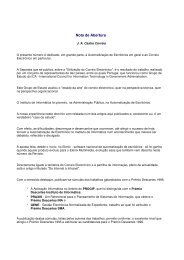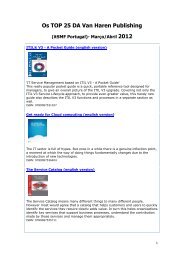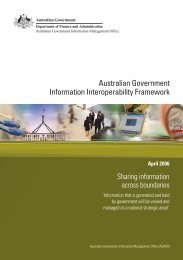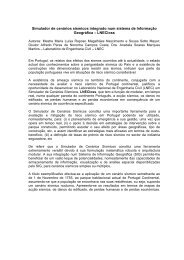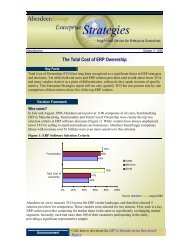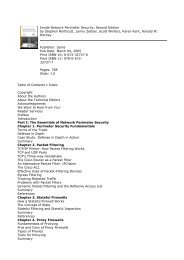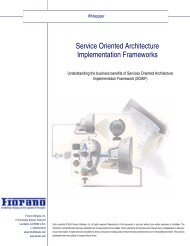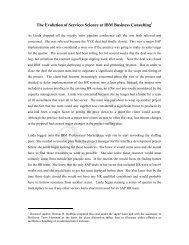OECD Peer Review of E-Government in Denmark - ePractice.eu
OECD Peer Review of E-Government in Denmark - ePractice.eu
OECD Peer Review of E-Government in Denmark - ePractice.eu
You also want an ePaper? Increase the reach of your titles
YUMPU automatically turns print PDFs into web optimized ePapers that Google loves.
Co-ord<strong>in</strong>ation <strong>of</strong> e-government policies and projects<br />
At State government level each m<strong>in</strong>istry plays a co-ord<strong>in</strong>at<strong>in</strong>g role for the various departments,<br />
agencies and bodies it is responsible for. This is most clearly seen <strong>in</strong> the process <strong>of</strong> budget allocation<br />
with<strong>in</strong> the overall m<strong>in</strong>isterial portfolio. However, <strong>in</strong>ternal co-ord<strong>in</strong>ation <strong>of</strong> e-government systems and<br />
applications development is <strong>in</strong>creas<strong>in</strong>gly evident. This is a result <strong>of</strong> the public sector modernisation<br />
programme, which requires all m<strong>in</strong>istries to prepare strategies that <strong>in</strong>clude a focus on improv<strong>in</strong>g the<br />
efficiency and quality <strong>of</strong> their services through better (“more qualified”) use <strong>of</strong> ICT.<br />
At the all-<strong>of</strong>-government level, rather than consolidat<strong>in</strong>g co-ord<strong>in</strong>ation responsibilities under a<br />
s<strong>in</strong>gle entity such as a chief <strong>in</strong>formation <strong>of</strong>ficer, <strong>Denmark</strong> has <strong>in</strong>volved several m<strong>in</strong>istries <strong>in</strong><br />
co-ord<strong>in</strong>at<strong>in</strong>g e-government accord<strong>in</strong>g to how it fits with their wider responsibilities, functions and<br />
expertise. As noted <strong>in</strong> Chapter 4, while this creates potential for duplication <strong>of</strong> roles and/or lack <strong>of</strong><br />
clarity, this is generally not seen to be a significant problem <strong>in</strong> <strong>Denmark</strong>. However, there is still room<br />
for improvement. Overall, <strong>Denmark</strong>’s current arrangements for top-level plann<strong>in</strong>g, co-ord<strong>in</strong>ation and<br />
leadership <strong>of</strong> e-government have contributed significantly to its achievements, and there is strong<br />
support, both with<strong>in</strong> and outside government, for cont<strong>in</strong>uation <strong>of</strong> these arrangements beyond 2006.<br />
Through the Digital Task Force, the M<strong>in</strong>istry <strong>of</strong> F<strong>in</strong>ance plays the most prom<strong>in</strong>ent e-government<br />
co-ord<strong>in</strong>at<strong>in</strong>g role at the all-<strong>of</strong>-government level. This role, which is focused on cross-organisational<br />
issues that arise from, or impact on, the e-government strategy, has grown alongside a broader push<br />
from the <strong>Government</strong> for more public sector co-ord<strong>in</strong>ation aimed at achiev<strong>in</strong>g better results. This push<br />
is partly a response to the cross-cutt<strong>in</strong>g nature <strong>of</strong> most major policy issues <strong>in</strong> <strong>Denmark</strong>, and partly due<br />
to an e-government-generated awareness <strong>of</strong> the need to develop a culture <strong>of</strong> collaboration <strong>in</strong> the public<br />
sector. It has led to <strong>in</strong>creased question<strong>in</strong>g <strong>of</strong> the traditionally high levels <strong>of</strong> <strong>in</strong>dependence and<br />
decentralised powers <strong>of</strong> decision mak<strong>in</strong>g that government organisations have enjoyed. In 2003, a<br />
major review <strong>of</strong> the e-government strategy and Project e-<strong>Government</strong> identified the need to extend the<br />
project until the end <strong>of</strong> 2006. As already noted <strong>in</strong> Chapter 4, it also brought to light a number <strong>of</strong><br />
challenges and obstacles <strong>in</strong> front <strong>of</strong> the project, <strong>in</strong>clud<strong>in</strong>g a widespread “bunker” (silo) culture <strong>in</strong><br />
government that acted to <strong>in</strong>hibit collaboration.<br />
In consider<strong>in</strong>g how to address these obstacles, the Jo<strong>in</strong>t Board <strong>of</strong> e-<strong>Government</strong> looked at the<br />
tension between co-ord<strong>in</strong>ation and centralisation as approaches to implementation <strong>of</strong> the e-government<br />
strategy. The outcome was an acknowledgement <strong>of</strong> the importance <strong>of</strong> us<strong>in</strong>g both approaches to<br />
achieve the Danish e-government vision, and a shift from “s<strong>of</strong>t” to “strong” co-ord<strong>in</strong>ation as the<br />
overall approach to implementation <strong>of</strong> the e-government strategy. S<strong>in</strong>ce 2004, the overall strategic<br />
approach to e-government has <strong>in</strong>volved more active direction and support from the centre <strong>of</strong><br />
government that features a notable <strong>in</strong>crease <strong>in</strong> attention to development <strong>of</strong> all-<strong>of</strong>-government<br />
co-ord<strong>in</strong>ation frameworks and common ICT <strong>in</strong>frastructures.<br />
The M<strong>in</strong>istry <strong>of</strong> Science, Technology and Innovation (MVTU) has the other major e-government<br />
co-ord<strong>in</strong>at<strong>in</strong>g role, due both to its overall responsibility for Danish ICT policy and the close<br />
<strong>in</strong>volvement <strong>of</strong> its IT-Policy Centre <strong>in</strong> Project e-<strong>Government</strong>. The pr<strong>in</strong>cipal task <strong>of</strong> the M<strong>in</strong>istry is to<br />
develop and implement key <strong>in</strong>itiatives <strong>of</strong> the <strong>Government</strong>’s ICT policy, and to contribute to creat<strong>in</strong>g<br />
the best possible framework for citizens, bus<strong>in</strong>esses and the public sector to realise <strong>in</strong>formation society<br />
goals. The M<strong>in</strong>istry’s co-ord<strong>in</strong>ation responsibilities are carried out <strong>in</strong> a variety <strong>of</strong> ways, particularly<br />
through its role <strong>in</strong> develop<strong>in</strong>g the Danish enterprise architecture and ICT standard sett<strong>in</strong>g (discussed<br />
below); for example, the work <strong>of</strong> the XML Committee is managed by the National IT and Telecom<br />
Agency, located under the MVTU.<br />
90



